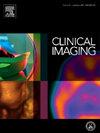Use of Spinosum Roentgen Index (S.R.I.) to determine candidacy for middle meningeal artery embolization
IF 1.8
4区 医学
Q3 RADIOLOGY, NUCLEAR MEDICINE & MEDICAL IMAGING
引用次数: 0
Abstract
Introduction
Middle meningeal artery embolization (MMAe) is a minimally-invasive approach for the treatment of subdural hematomas (SDH). Small vessel caliber and ectopic origin of the middle meningeal artery (MMA) may lead to unsuccessful embolization and/or serious morbidity. Thus, use of an objective scale to pre-procedurally assess candidacy for MMA embolization is an essential component of operative planning.
Methods
A retrospective analysis of all patients having undergone MMAe across 4 years at a single institution was performed.
Results
169 MMAe procedures were performed for SDH, of which 3 were found to have a foramen spinosum diameter, termed the “Spinosum Roentgen Index” (SRI), measuring <2 mm on pre-procedure non-contrast CT Head. A statistically-significant correlation was found between foramen spinosum diameter <2 mm and unsuccessful embolization.
Conclusion
Assessment of foramen spinosum diameter (Spinosum Roentgen Index (SRI)) may increase suspicion for aberrant MMA anatomy when measuring <2 mm, which can serve as valuable data in assessing risk versus benefit of MMA embolization, and ultimately minimize unexpected intraprocedural or immediate postprocedural complications.
求助全文
约1分钟内获得全文
求助全文
来源期刊

Clinical Imaging
医学-核医学
CiteScore
4.60
自引率
0.00%
发文量
265
审稿时长
35 days
期刊介绍:
The mission of Clinical Imaging is to publish, in a timely manner, the very best radiology research from the United States and around the world with special attention to the impact of medical imaging on patient care. The journal''s publications cover all imaging modalities, radiology issues related to patients, policy and practice improvements, and clinically-oriented imaging physics and informatics. The journal is a valuable resource for practicing radiologists, radiologists-in-training and other clinicians with an interest in imaging. Papers are carefully peer-reviewed and selected by our experienced subject editors who are leading experts spanning the range of imaging sub-specialties, which include:
-Body Imaging-
Breast Imaging-
Cardiothoracic Imaging-
Imaging Physics and Informatics-
Molecular Imaging and Nuclear Medicine-
Musculoskeletal and Emergency Imaging-
Neuroradiology-
Practice, Policy & Education-
Pediatric Imaging-
Vascular and Interventional Radiology
 求助内容:
求助内容: 应助结果提醒方式:
应助结果提醒方式:


